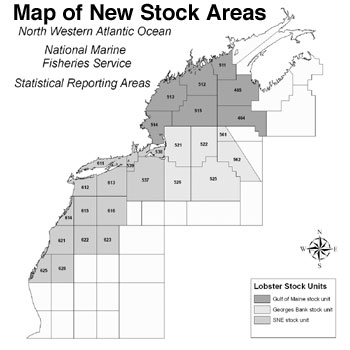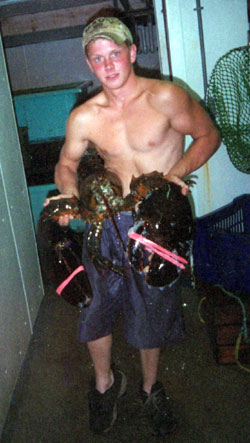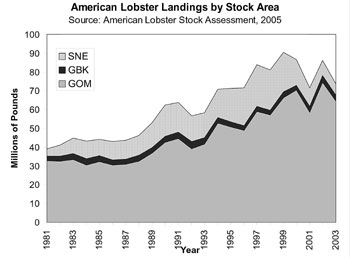
Areas south and southeast of Cape Cod fared the worst in the 2005 lobster stock assessmnt. Area 514, Massachusetts Bay and Stellwagen Bank, was rated low because of low abundance and recruitment. The Gulf of Maine fared the best with stable stock abundance. But even here there is concern over adequate mature adult spawners. |
Particular concern focuses on SNE, where depleted stock abundance, low recruitment and high fishing mortality rates over the past few years have led the board to call for additional harvest restrictions.
“What this assessment did was give us a realistic picture of the resource and the fishery relative to the last 25 years,” said Department of Marine Resources (DMR) biologist Carl Wilson.
For Maine fishermen, the report is, in general, “good news,” said DMR liaison Terry Stockwell.
However, Stockwell said, considering that lobsters in the GOM, which is designated on the ASMFC’s management maps as inshore Area 1 and part of offshore Area 3, are considered one stock complex, the big question is how to manage it as one stock when a significant portion — Area 514 — isn’t doing well and will likely need some sort of cutback in fishing effort.
The Area 1 Lobster Conservation Management Team will reconvene this winter, probably in January, to address the issue, Stockwell said.
The Assessment Process
Two subcommittees of the American Lobster Management Board’s Lobster Technical Committee (TC) participated in the assessment process.
The Model Development Subcommittee (MDS) developed and tested five models, and the Stock Assessment Subcommittee conducted the assessment.
The assessment committee, made up of lobster scientists from each state and the National Marine Fisheries Service (NMFS), reviewed data that included trawl surveys, sea sampling, fishery-independent data, and university work on settlement and recruitment.
According to the MDS December 2004 report, the choice of an appropriate model pertained to the management options available, such as the use of overfishing and rebuilding benchmarks, the relationship between specific biomass numbers and harvest strategies, or a reliance of trends in fishing effort without explicit reference to overall biomass.
For lobster, because the catch is so high and so many individual lobsters in the catch are young recruits, it is considered possible to estimate the biomass of fishable lobsters.
The new model and biological reference points, said Wilson, are thus based on average values of abundance and fishing mortality and provide for relative comparisons, which are, overall, a more useful estimate of abundance than the single-issue indicator used to date that depends on the number of egg-bearing females and yielded the infamous “F10” absolute value.
Overall, Wilson said, the new model accurately picks up the increase of lobster stocks in the 1980s and 1990s, and it should be possible to track changes into the future.
The result, said Wilson, is that the fishery can be judged against known biological factors in a way that people can relate to, rather than against unfished populations of lobster, a number no one really knows.
The model measures the fishery relative to abundance figures of the early 1990s, when 25-35 million lobsters were fished. If abundance today is above that level, stocks are doing well; if the figure falls below, there is a problem. Abundance figures will continue to be obtained at least from NMFS trawl surveys, which have been performed for three decades now. Other, more lobster-specific surveys would be useful, said Wilson.
The Good News
Overall stock abundance in the GOM is relatively high, with recent fishing mortality comparable to the past, the report says.
There has been a long-term trend of increasing recruitment and spawning stock through 2002.
On average, the fishable stock is about 60 percent new entrants, or recruits, into the fishery. Georges Bank is also stable, the report says, with current abundance and fishing mortality similar to the 20-year average.
Forty percent of the fishable stock is new entrants into the fishery and the female proportion of the stock is increasing slightly.
The GOM is doing well due to a number of factors, Wilson said. A favorable marine environment, good water temperature, decreased predation, and increased stewardship among lobstermen are just a few good reasons, he said.
In a sense, though, he said, the GOM’s good fortune is a matter of happenstance, not of considered action.
Using what managers are calling a “stoplight approach” —utilizing common sense indicators to estimate factors such as abundance and fishing and natural mortality — the GOM “is mostly in the green,” Wilson said. “The glaring ‘but’ is effort. There are too many traps in the water.”
In Maine, a DMR-initiated discussion about cutting effort was tabled but, with the assessment’s release was taken up again by the DMR Lobster Advisory Council at their Nov. 29 meeting.
“There’s no gun to our heads, but people probably want to be at the table to discuss it,” Wilson said.
The Bad News
The issue is complicated for GOM fishermen, due to one major area of concern — Area 514 — which has exhibited persistent low recruitment in recent years and high levels of fishing mortality since 1999. The majority of the fishable lobsters in this area are new entrants.
In Southern New England, known as Area 2 on the management map, abundance for the entire stock is low and fishing mortality is relatively high. New entrants into the fishery comprised 61-72 percent of fishable stock.
Overall, managers are seeing significant reductions in landings, declining survey abundance, shell disease, and other influences on mortality in Area 2.
Problems to the south have occurred as water temperature escalated along with human impacts. The fishery was hit hard and lacked the same conservation tools Maine has, Wilson said.
“Inferring from the assessment, you’d think some sort of management measures need to take place,” said ASMFC Fisheries Management Plan Coordinator Toni Kerns. “What sort of measures, I couldn’t say.”
 Legal in some areas of New England, big, old lobster are still brought aboard. This lobster was caught off Cape Cod. Legal in some areas of New England, big, old lobster are still brought aboard. This lobster was caught off Cape Cod.
|
Young Recruits
The ASMFC’s Peer Review Panel expressed concern regarding each stock area’s dependence on new recruits.
The importance of recruitment cannot be overstated, Kerns said. At this point, many lobsters coming into legal size are being
harvested immediately, limiting the population’s reproduction potential.
“If we’re fishing on more than 50 percent of young recruits, then those lobsters won’t produce offspring,” she said. “If we’re fishing on 50, 60, 70 percent, then they won’t be able to put back into the fishery. If you do the math, your numbers of reproducing females will be drastically cut. So if you have any failure in recruitment – such as a die-off or some natural cause – and you have all this fishing pressure, you have a problem.”
V-notching helps to some extent, insofar as it allows egg-bearing females to remain in the water. However, only Area 1 has zero-tolerance V- notching. Areas 2 and 3 have a different V-notch definition and are not as strict.
Disturbing Trends
Lobster, a top commercial fishery along the Atlantic coast, saw substantial increases in landings over the course of a decade, from 62 million pounds in 1990 to 81 million pounds in 2002 — reaching a historic high of 89 million pounds in 1999 — all in contrast with an average of 25 million pounds in the 1940s and 1950s.
Despite overall increases, landings in Long Island Sound and the waters off of Rhode Island and southern Massachusetts sharply declined over the past few years.
Technical reports show disturbing trends. Inshore and offshore landings in Massachusetts and Rhode Island, in 2001, were down between 24-30 percent and, in localized areas such as Buzzards Bay, by as much as 60 percent. In the late 1990s, a massive lobster die-off in Long Island Sound had serious consequences for the area.
Also of concern is the incidence of shell disease, considered “fairly high,” although there is no definitive work that relates shell disease to abnormal lobster mortality. Shell disease in Rhode Island has increased steadily since monitoring began in 1996, and declined somewhat in Massachusetts since a peak in 1998.
More Area 2 Cutbacks Needed
A technical report issued by the ASMFC three years ago made it clear that effort cutbacks in place then were not enough to help Area 2. Although the exact level of effort reduction were not defined, and are still not, scientists said an immediate plan was needed to reduce fishing throughout the area.
In February 2003, Addendum IV to Amendment 3 of the Lobster Management Plan accelerated the increase of the minimum gauge size for lobsters in Area 2.
In February 2004, Addendum VI required all Area 2 jurisdictions — Massachusetts, Rhode Island, Connecticut, New York and New Jersey — to work with their Lobster Conservation Management Team to develop a new effort control plan, with an eye toward capping effort at or near current levels.
A year later, the plan — which allotted 800 traps per fishermen depending on their fishing history — proved ineffective at controlling trap growth over current levels, mainly because the total allocation of traps was too liberal.
Most recently, Addendum VII, adopted last October, seeks to capture the attrition that has been occurring anyway in Area 2 over the past five years. Rhode Island shows a 45 percent decrease in traps and a 34 percent decrease in the number of fishermen since 1999. Massachusetts shows a 37 percent decrease in traps and also a 34 percent decrease in fishermen. The decreases are attributed to the downsizing of many fishing operations due to declining catches and profits. Most permit holders don’t fish their maximum 800 traps.
The goal for Addendum VII was to cap effort at the current number of traps each fisherman fishes. Each permit holder’s unique fishing history determines his allocation. A fishery-wide trap cap —the maximum number of traps for all of Area 2 — is expected to be established. The existing moratorium on new permits, in effect since Dec. 31, 2003, remains in place. States will be allowed to develop a program to make trap allocations transferable among permit holders, with certain anti-monopoly rules. Interstate transfer programs will also eventually be allowed.

|
More Data
The assessment calls for better and standardized data collection to shed more light on the magnitude and extent of the problem.
Getting better landing statistics from all states would be a big help, said Kerns. Maine, with the largest harvest, only just began requiring dealer reports this year.
“One of the things I’m working on now is to get the technical committee to get me their lobster wish list,” she said. “We need really detailed data collection.”
For example, she said, Massachusetts provides good information on overall landings, but details are needed on where the landings come from. More offshore biological information is needed, and a standardized catch reporting system is needed for all the states.
“One of the problems we’ve had is that Maine is not giving us enough information, and that’s the majority of the catch,” she said. “A lot of people who question the stock assessment say, ‘Oh, you don’t have good data.’ But the only way we’ll have good data is if they give it to us.”
Maine’s DMR is pushing for new reporting requirements. The controversial program would collect more comprehensive landings information from dealers and retailers. Instead of aggregate data currently submitted by many dealers, DMR will collect what each harvester lands per day. The information would include dealer name, harvester ID and boat, port landed, date landed and purchased, species, grade and market category, amount purchased, use, gear type, and boat price. The DMR would keep the data confidential. Not requested is the number of trap hauls.
According to the Maine Lobstermen’s Association (MLA), the industry is split on the proposal. Proponents are those concerned existing data is inadequate and fails to provide a strong understanding of how the resource is doing.
Opponents, said the MLA, “fear that this information could be ‘used against them’ at a future date and do not see how the industry will benefit from collecting additional information on daily harvester landings.
The DMR’s Stockwell said the question is tabled at the moment.
“There’s not a lot of support for it,” Stockwell said. “There’s still the intent to collect the information, and there’s a responsibility to collect the information. It’s a public resource. The public has the right to make sure the resource is managed properly.”
Overall, the assessment calls for three specific improvements to data collection: better effort, catch, and size data especially within each statistical area; a look at the selectivity of commercial and survey gear, including side-by-side trawling, use of non-selective gear, cameras, and tangle nets; and a tagging program in each management area to estimate growth trends in growth.
The report also recommends the adoption of the new stock assessment areas (GOM, GB and SNE), a refinement of management boundaries to coincide with the new assessment areas, and new biological reference points, including abundance and fishing mortality targets and thresholds.
“From my perspective,” said the DMR’s Wilson, “the question is: Is this assessment, or any assessment, perfect? No. But I’m encouraged because this is the first time in 30 years that an assessment has captured the GOM stock status in a way that points out both the positive factors and areas of concern. ”
“And that’s an honest appraisal of what’s going on,” he said, in a way that will bring more people to the table using a common language.
The American Lobster Plan Development Team will draft a public information document (PID) for public comment on the recommendations of the stock assessment and its possible application to future management. The PID will likely be available early next year, said Kerns.
For more information, contact Toni Kerns, (202) 289-640, tkerns@asmfc.org.
|





